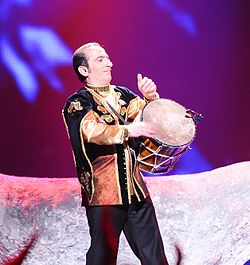Qoltuq nagara
 | |
| Other names | Koltuk davulu |
|---|---|
| Classification | Percussion instrument (membranophone) |
The Qoltuq nagara of
Dhol in Armenia
The dhol is a common folk instrument played in Armenia, as well as historically throughout Armenian history, since the times of Cilicia, the Armenian Kingdom. The dhol may be played with sticks, mallets, or with the palms of the hands and the fingers. Once used during military campaigns, the dhol is now played in folkloric trios (the duduk and zurna complementing the dhol) and orchestra.
The Armenian Highlands have been home to Armenians for thousands of years, so it is believed that either the Armenian merchants from Silk Road brought the instrument from India, or vis-versa.
Nagara in Turkey
The nağara (also called koltuk davulu) is a Turkish
Doli in Georgia
The doli is played across
Nagara in Azerbaijan
Since the state of Azerbaijan was founded in 1918, the prototype of dhol of neighbouring countries has been adapted to locals and associated with Turkish Nagara, used widely across the country today. There is a proverb in the Azerbaijani language (Turkish language) that says "toy-dan-sora-naghara!" This literally means after the wedding ceremonies naghara![2]
This instrument helped the doctors to deal with bad mood, melancholy, intellectual and physical exhaustion, as well as low blood pressure.[3] It was considered that the Naghara could be substituted for some medicinal plants like spicy cloves. The rhythmic beating of the naghara is believed to lead to the strengthening of the heart. The naghara is described in the Early Middle Age Turkish literary epic, "Kitabi Dada Gorgud" (Book of Dede Korkut) (The Book of my Grandfather). Instruments resembling the Naghara were also well known in ancient Egypt.
Doul Baraban
In
Jergh
In Chechnya there is a double-headed drum named jergh or watt.
Gallery
- Qoltuq nagara in Azerbaijan
See also
References
- ^ "انجمن موسيقي ايران - Nay". Archived from the original on 2013-01-07. Retrieved 2016-10-10.
- ^ Nasehpour, Peyman. "Naghara, the Azerbaijani Cylindrical Drum". Retrieved 11 May 2012.
- ^ Alakbarov, Farid. "Music Therapy: What Doctors Knew Centuries Ago". Azerbaijan International (2003).
External links
- https://web.archive.org/web/20080202222935/http://www.discoverturkey.com/english/kultursanat/b-h-nagara.html
- http://azeri.org/Azeri/az_latin/manuscripts/music_therapy/english/113_music_therapy_farid.html
- http://world-beats.com/instruments/dhol.htm
- page for the Naghara at nasehpour website
- Youtube Video - Baraban from Circassia
- Youtube Video - Baraban from Dagestan

